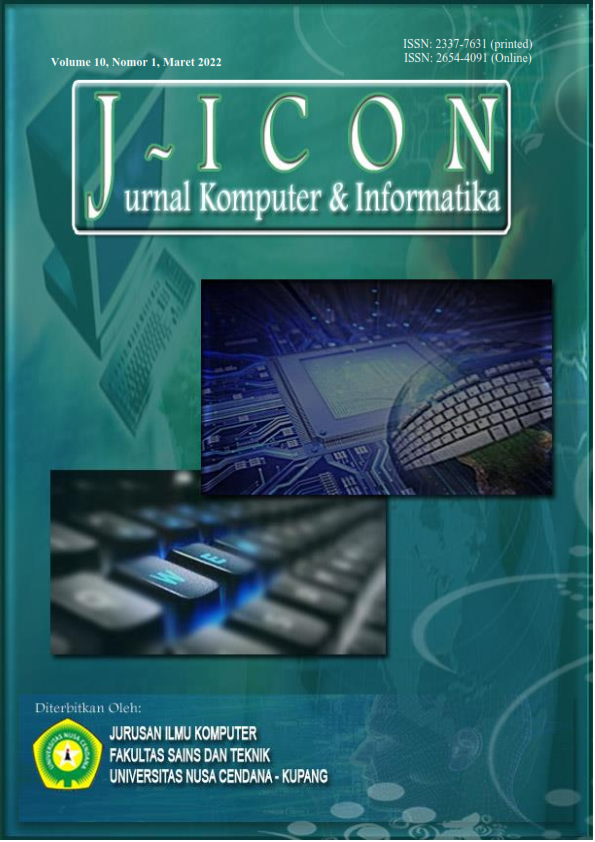Classification of Determining Pancemic Status in Kupang City Using Naive Bayes Classifier Algorithm
Abstract
The World Health Organization (WHO) made the corona virus a pandemic in 2020. This virus has hit the whole world, including Indonesia. East Nusa Tenggara (NTT) as of June 2021 recorded 18,741 positive cases of Covid-19 and the City of Kupang was the area that contributed the most positive cases. The daily increase in Covid-19 cases in Kupang City shows a fairly high increase. The purpose of this study is to build a classification system to determine the status of the Covid-19 zone in the city of Kupang. The system design using the waterfall model is used to design and build the system while the Naïve Bayes Classifier algorithm is used for classification. The criteria as input in the system for the classification process are positive confirmed data, recovered patient data and death data. The results of the classification process consist of 2 classes, namely the Green Zone and Red Zone. Kupang City's daily Covid-19 case data for January-June 2021 with a total of 181 as training data. 31 test data entered into the system were analysed using the Naïve Bayes Classifier method and succeeded in obtaining classification results as system output. Tests in the study were carried out on systems built using Blackbox testing to test the functionality of the system with the expected results. The confusion matrix is used to test the performance of the classification method and the results have an accuracy rate of 77.91% and a precision value of 73.91%.
Downloads
References
“Coronavirus disease (COVID-19).” https://www.who.int/emergencies/diseases/novel-coronavirus-2019/question-and-answers-hub/q-a-detail/coronavirus-disease-covid-19 (accessed Feb. 27, 2022).
P. Vermonte and T. Y. Wicaksono, “Karakteristik dan Persebaran Covid-19 di Indonesia: Temuan Awal,” CSIS Comment., vol. 1, pp. 1–12, 2020.
W. R. P. COVID-19, “Peta Sebaran,” covid19.go.id. https://covid19.go.id/peta-sebaran (accessed Feb. 27, 2022).
“Dia adalah pasien COVID-19 pertama di Nusa Tenggara Timur. Sekarang dia menjadi pejuang imunisasi.” https://www.unicef.org/indonesia/id/coronavirus/cerita/dia-adalah-pasien-covid-19-pertama-di-nusa-tenggara-timur-sekarang-dia-menjadi-pejuang (accessed Feb. 27, 2022).
A. P. Wibawa, A. C. Kurniawan, H. A. Rosyid, and A. M. M. Salah, “International Journal Quartile Classification Using the K-Nearest Neighbor Method,” in 2019 International Conference on Electrical, Electronics and Information Engineering (ICEEIE), Denpasar, Bali, Indonesia, Oct. 2019, pp. 336–341. doi: 10.1109/ICEEIE47180.2019.8981413.
M. Misdram, F. Syarifuddin, and A. A. Widodo, “Klasifikasi Data Set Virus Corona Menggunakan Metode Naïve Bayes Classifier,” Spirit STMIK Yadika J. Comput. Cybern. Syst., vol. 12, no. 2, pp. 46–52, 2020.
M. Ikbal, S. Andryana, and R. T. K. Sari, “Visualisasi dan Analisa Data Penyebaran Covid-19 dengan Metode Klasifikasi Naïve Bayes,” J. JTIK J. Teknol. Inf. Dan Komun., vol. 5, no. 4, pp. 389–394, 2021.
R. S. Pressman, Rekayasa Perangkat Lunak, 7th ed. Yogyakarta: ANDI, 2012.
R. Susanto and A. D. Andriana, “PERBANDINGAN MODEL WATERFALL DAN PROTOTYPING UNTUK PENGEMBANGAN SISTEM INFORMASI,” Maj. Ilm. UNIKOM, vol. 14, no. 1, May 2016, doi: 10.34010/miu.v14i1.174.
M. F. A. Saputra, T. Widiyaningtyas, and A. P. Wibawa, “Illiteracy Classification Using K Means-Naïve Bayes Algorithm,” JOIV Int. J. Inform. Vis., vol. 2, no. 3, p. 153, May 2018, doi: 10.30630/joiv.2.3.129.
U. ERKAN and L. GÖKREM, “The Classification of the Students Success Via the Informations Existing in E-School System,” Int. J. Educ. Res., vol. 4, no. 4, pp. 225–232, 2016.
N. Hadianto, H. B. Novitasari, and A. Rahmawati, “KLASIFIKASI PEMINJAMAN NASABAH BANK MENGGUNAKAN METODE NEURAL NETWORK,” J. Pilar Nusa Mandiri, vol. 15, no. 2, pp. 163–170, Sep. 2019, doi: 10.33480/pilar.v15i2.658.
M. Sokolova and G. Lapalme, “A Systematic Analysis of Performance Measures for Classification Tasks,” Inf. Process. Manag., vol. 45, no. 4, pp. 427–437, 2009, doi: 10.1016/j.ipm.2009.03.002.
Copyright (c) 2022 Nelci Dessy Rumlaklak, Adriana Fanggidae, Yulianto Triwahyuadi Polly

This work is licensed under a Creative Commons Attribution 4.0 International License.
The author submitting the manuscript must understand and agree that if accepted for publication, authors retain copyright and grant the journal right of first publication with the work simultaneously licensed under a Creative Commons Attribution (CC-BY) 4.0 License that allows others to share the work with an acknowledgment of the work’s authorship and initial publication in this journal.
 Nelci Dessy Rumlaklak(1*)
Nelci Dessy Rumlaklak(1*)




